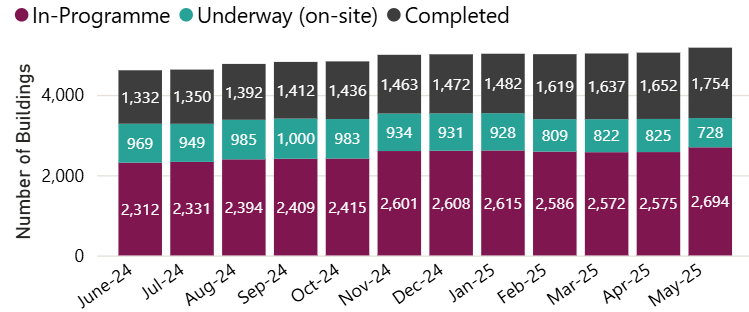


Acoustic Implications of Recladding High-Rise Buildings
The recladding of high-rise buildings has become a major focus since Grenfell, with thousands of buildings across the UK undergoing works to replace unsafe (i.e. potentially flammable) façade materials. According to government figures (May 2025), over 1,700 buildings have been completed, more than 700 are in progress, and work has yet to start on almost 2,700 more.
The primary driver is of course fire safety. However, poorly considered changes to glazing, ventilation or cladding systems can create acoustic issues with the potential to result in claims and negative PR against developers, contractors and building operators undertaking the work. This scrutiny is likely to increase as Resident Engagement groups are given more power under the current legislation.
This article outlines the key acoustic risks to assess when recladding, and how we are already helping our Clients achieve compliance and minimise their risk of PR issues and claims related to acoustic performance.

External Sound Insulation
High-rise buildings are often located close to major noise sources such as roads, railways, airports and industrial facilities. The design of the external façades — including glazing and ventilation — dictate internal noise levels. If the new systems have a lower acoustic performance than the existing systems, the noise levels in the building will increase as a result.
Planning requirements are often imposed to ensure this is considered, however, given the risk of negative PR and claims, an acoustic assessment of the proposed façade design is strongly recommended in any case.
Overheating and Thermal Comfort
Recladding typically improves a building’s thermal performance, reducing heat loss in winter. However, better insulation also increases the risk of overheating in warmer months, increasing residents’ reliance on open windows for thermal comfort and exposure to high noise levels.
To prevent problems, overheating assessments should be carried out alongside noise assessments, particularly for buildings close to significant noise sources. This ensures that both thermal comfort and acoustic comfort are protected.
Acoustic Separation Between Dwellings
In most cases, the sound insulation between dwellings (across separating walls and floors) is unaffected by recladding. However, buildings with curtain walling can present risks: sound may travel vertically or horizontally through the walling system, undermining acoustic separation between dwellings.
How Cass Allen Can Help
Cass Allen is already supporting clients with the design and specification of recladding systems. We add value by:
- Undertaking site noise surveys to quantify risks
- Reviewing cladding proposals to identify potential acoustic issues early
- Making sure works do not introduce new or worse acoustic problems for residents
- Helping achieve compliance with any relevant Building Regulations or planning requirements
- Preparing clear acoustic specifications for recladding systems
- Undertaking on-site acoustic testing of installed systems to demonstrate performance

Conclusion
Recladding programmes are rightly focused on fire safety. However, relatively inexpensive acoustic design assessments can protect developers, contractors and building managers against damaging PR and claims down the line.
If you are planning or already undertaking recladding works, call us on 01234 834862 or email mail@cassallen.co.uk to discuss your project and how we can help.








